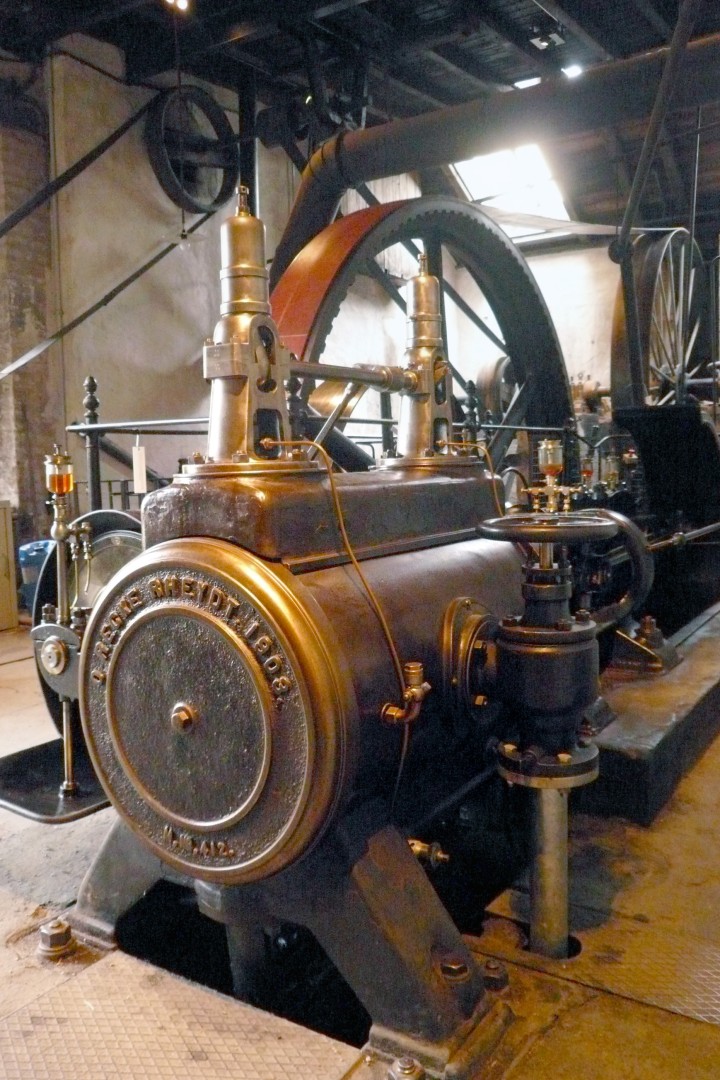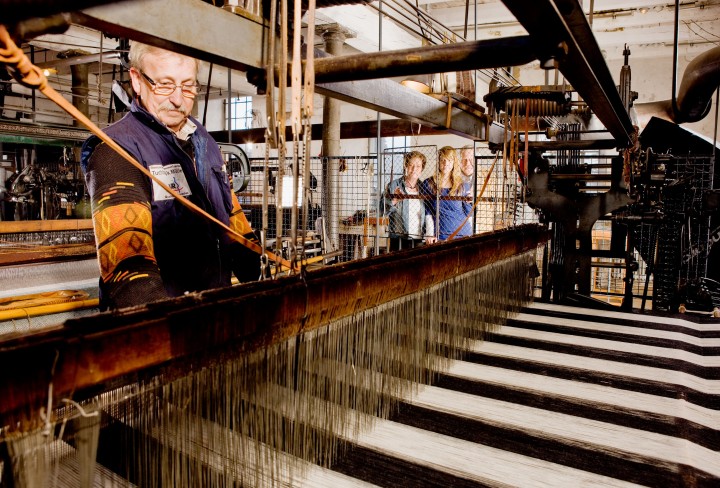Alle Standorte des LVR-Industriemuseums sind vom 23.12.2025 bis einschließlich 1.1.2026 geschlossen.

Euskirchen. For travelling back in time, one does not necessarily need a time machine. This fascinating adventure is also offered to its visitors in the former cloth factory Müller in Euskirchen-Kuchenheim by the LVR-Industriemuseum Euskirchen. Here, you feel as if you were set back a few centuries. When the business of the factory, which existed since 1894, got worse in 1961, the factory owner simply shut the gates and left the production site as it was. Almost 30 years, it lay in wait and then was unlocked again. Today, it is an exceptional museum.
The tour through the old production site is astonishing. Everything remained untouched: The calendar on the wall shows the date of the closure, when the machines in the factory stopped and the gates were closed. On the door of the dye-work, the chalk writing of Ludwig Müller, who wrote a recipe for a dyeing solution on the gate, is still visible. Cigarette packs, an old coffee cup, loads of handwritten notes. All these things convey an impression of the last day of work.
And then the old looms start working again. The weaving shuttles dash back and forth. Loose wool is made into exquisite cloth. Huge carding machines are combing the wool; filigree spinning machines are forming a fine yarn. At the regularly held “steam-Sundays” even the mighty steam engine from 1903 can be observed in full action.
The exhibition site Euskirchen of the LVR-Industriemuseum is an extraordinary place. It conveys an image, as if history itself furnished the museum: The machines and tools, the big and small things are still where they always belonged. Films, small installations and models support the experience of the factory’s world and tell about the work, about heat and steam in the dye-work, about the fascinating mechanism of the transmission with its countless gearwheels and cogs. Short extracts of interviews with former employees make their experiences and feelings vivid again.
In 1988, the LVR-Industriemuseum took over the former cloth factory Müller. The experts had to take a huge challenge: broken roofs, rusting machines, cobwebs, ivy and the dust from centuries. The unique general impression of buildings, machines and several thousand inventory pieces should not have been interfered with. Still, the buildings had to be prepared for the modern demands of a museum. The sensitive and carefully restored cloth factory presents itself since 2000 in an excellent appearance to its visitors and fascinates with its authentic atmosphere.
In the museum’s shop, unique products out of the museum’s production are offered: warm woollen blankets, beautiful bags and even jackets and coats made of “Müller cloth”. In the new building also the museum’s café is located, where even large groups can find a place for coffee and cake (table-service on request).
As versatile as the museum itself is its educational programme. Fitted to various age groups and school types, many activities about wool and the cloth factory are offered: balls, pictures and other colourful objects can be felted. Unique pieces of art are created on weaving frames. In the design-workshop, one’s own fantasy can be transferred into one’s favourite piece of fashion. Offers as “Dyeing with indigo” or “Animals and plants in and around water” near the stream or “With water and steam: what drives the machines in the factory” are focussed more on scientific and technical topics.
A huge happening for the site Engelskirchen and its visitors is the traditional wool market, which happens every year on the first Sunday in June. A variety of offers turns this event into a unique experience: The market, with its round about 100 different stalls, offers a wide range of products from the areas of wool, clothes, old crafting and design. Furthermore, sheep are shorn, border-collies prove their skills as sheepdogs in a show, games and participative actions invite the visitors to stroll around and stay for a while. Also the culinary part does not miss out: delicacies from the Eifel as well as many different dishes made of sheep can be tried and bought.
A hike or a tour with the bike in the rural surroundings or in the nearby Eifel completes the trip to Kuchenheim. Two sign-posted bike routes cross at the LVR-Industriemuseum and lead further to the beautiful natural and cultural sites in the close and further surroundings. The museum also offers its own bike rent shop: 30 high-quality bikes for adults and 35 bikes for adolescent can be rented here for a small fee.
The museum-guesthouse Mottenburg is a special extracurricular learning space for school- and youth-groups. During an eventful three to five day stay the young guests do not only get to know the cloth factory, but also the production of cloth in the pre-industrial era. By doing their own spinning and weaving, they learn in practice how much work has to be done for our clothes. Companies, clubs and private people can here find an attractive possibility for conferences and celebrations.
The cloth factory Müller in Euskirchen is one of a total of seven exhibition sites of the LVR-Industriemuseum, which combined, create a unique museum. In historical factories, of which some are listed for preservation, the history of the industry in the Rhineland and its workers is told in an interesting and illustrative way. The focus is put on metal, fabrics, paper and electricity, as the local branches. Apart from the cloth factory Müller the other museums are waiting to be explored: the Gesenkschmiede Hendrichs in Solingen, the Kraftwerk Ermen & Engels in Engelskirchen, the Textilfabrik Cromford in Ratingen, the Papiermühle Alte Dombach in Bergisch Gladbach, the Zinkfabrik Altenberg as well as the St. Antony-Hütte in Oberhausen. Furthermore, the museum’s headquarter with management, administration, depositories, library, photo archive and garages is placed in Oberhausen. Founder and bearer of the LVR-Industriemuseum is the Landschaftsverband Rheinland (LVR).
LVR-Industriemuseum
Tuchfabrik Müller
Carl-Koenen-Straße
53881 Euskirchen
kulturinfo rheinland
Tel.: 02234 / 9921-555 (Mon-Fri 8 am – 6 pm; Sat, Sun 10 am – 3 pm)
Fax: 02234/9921300
Mail: info@kulturinfo-rheinland.de
Tuesday to Friday 10 am – 5 pm
Saturday and Sunday 11 am – 6 pm
Mondays closed
Regular entrance: 8 €, reduced 4 €
Children and adolescent up to 18 years get free admission to the museum!
Tuesday to Saturday: 11 am, 2 and 3:30 pm
Sunday: 11 am, noon, 1, 2, 3 and 4 pm
The following photographs are only to be used for editorial purposes in the context of coverage about the LVR-Industriemuseum and have to be marked with the copyright “©LVR-Industriemuseum”. Their printing is free of charge, but we would like to receive a specimen copy. The usage outside of this context is prohibited.

The steam engine from 1903 drove all machines till 1961. Once a month – on so called-Steam Sundays – it can be marvelled in full operation.
© LVR-Industriemuseum

Factory yard of the cloth factory – with the main building, which was built in 1801 as a paper mill.
© LVR-Industriemuseum

A machine demonstrator at a weaving-loom. One can vividly experience the loud production progress of the looms and ask many questions.
© LVR-Industriemuseum

The castle’s tower and water-filled moats: both are leftovers of the former weir of the “Obere Burg” (upper castle).
© LVR-Industriemuseum